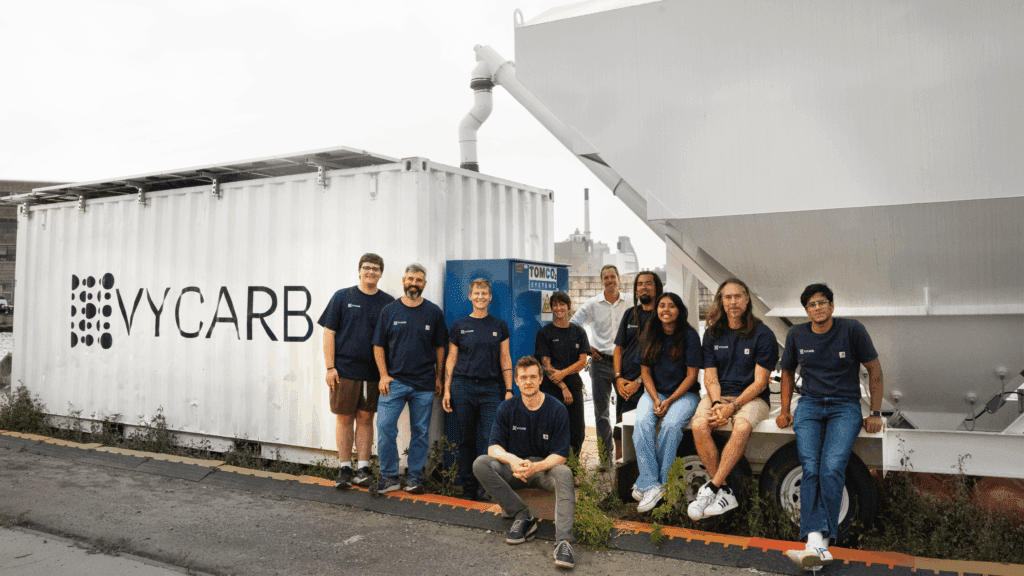Vycarb Wants to Supercharge the Ocean’s Climate-Fighting Power
By mimicking and accelerating natural CO₂ storage in seawater, this Brooklyn-based startup is tackling the climate crisis head-on
Shipping containers may be a common sight along New York City’s East River, but a solitary unit on a dock in Brooklyn Navy Yard is special, not only because of the pristine white paint covering its ribbed steel sides, or the solar panels on its roof, but because of what’s inside.
The 20-foot rectangular box houses the control instrumentation for one of the more promising technologies currently being investigated for enhancing the ocean’s natural ability to absorb and store carbon dioxide (CO₂). Drawing alkaline minerals from the hopper at its side and brackish water from the river, instruments in this bright white container control a chemical process that transforms the CO₂ in the water to bicarbonate and carbonate ions – stable, dissolved, and inert material that could remain trapped in the ocean for thousands of years.
The process, a form of ocean alkalinity enhancement, uses naturally existing minerals to increase alkalinity in water, enhancing the ocean’s ability to store carbon in stable forms.

Tapping Into the Ocean’s Natural Carbon Sink
“The ocean absorbs about ten billion tons of carbon dioxide pollution every year, with most of it naturally converted to bicarbonate – the largest carbon sink on the surface of the planet,” says Garrett Boudinot, the founder and CEO of Vycarb, the company piloting its carbon capture and storage system in the Brooklyn Navy Yard. “We saw how the ocean was naturally storing carbon dioxide and thought, ‘wouldn’t it be great if we could leverage that for industrial-scale decarbonization?’ And that’s what led to Vycarb.”
One can’t ignore the ocean when studying climate change. Making up 71 percent of the planet’s surface, it affects both weather and climate by absorbing solar radiation and distributing that heat across the planet, influencing ocean and atmospheric temperatures and driving global weather systems.
"The ocean absorbs about ten billion tons of carbon dioxide pollution every year, with most of it naturally converted to bicarbonate – the largest carbon sink on the surface of the planet."
Garrett Boudinot, Founder and CEO of Vycarb

Greenhouse Gases and the Ocean
The relative equilibrium between the ocean and the atmosphere has been significantly disrupted, however, by the steady output, and buildup, of greenhouse gases during the modern era. Excess greenhouse gases in the atmosphere from deforestation and from burning fossil fuels are trapping far more heat from the sun, warming the ocean, robbing oxygen from the water, and intensifying destructive storms.
If we want to restore the natural systems that protect shoreline communities, allow marine life to thrive, and provide food for more than three billion people, we must resolve the greatest threat to our ocean: an overabundance of CO₂ and other greenhouse gas pollution in our air and oceans.
Why Carbon Removal Is Necessary
Reducing new greenhouse gas emissions is necessary but not sufficient to achieve global climate targets: as we reduce our dependence on fossil fuels, we must also work toward cleaning up carbon dioxide pollution already in the air and oceans.
The ocean is our ally when it comes to climate change. For more than 150 years of rapid industrialization, the ocean has moderated the impacts of climate change for the benefit of human and non-human organisms and ecosystems by absorbing a huge amount of CO₂ from the air. But roughly 30 percent of that excess carbon dioxide is trapped in the ocean’s surface waters, making the water more acidic and causing widespread damage to ocean ecosystems, from coral reefs to oyster beds.
Ocean alkalinity enhancement accelerates the ocean’s natural process to lock away CO₂, reducing CO₂ levels in the atmosphere.
From Academia to Action
Until recently, Boudinot was on his way to a career as a climate researcher, earning a PhD in geology from the University of Colorado, working as a Research Associate at Cornell and serving on New York’s Climate Impacts Assessment working group. At some point, though, he says, “I got tired of studying the problem. I was convinced the problem was real and I said, ‘OK, what are we going to do about it?’”
There’s plenty of scientific complexity to what Vycarb does, but when asked, Boudinot offers a quotidian description of the company’s mission. “Carbon management. It’s just like waste management. CO₂ is waste and we’re trying to keep it out of the atmosphere.”
Some of the early research into removing CO₂ from the air focused on direct air capture, using technologies that remove the pollutants from the air, or carbon capture, which removed it at the source (e.g. smokestacks). The most common obstacle to these technologies is storage, and the most common solution is injection deep underground. Instead, Boudinot was studying how the ocean’s natural carbon sink was permanently storing CO₂ and asked, “How can we accelerate and control that process to open and unlock the ocean carbon sink for storage?”
Accelerating Through Launchpad
The company, which now has 10 employees, got started in 2022 with the Activate NY Fellowship, quickly deploying real-world testing including a pilot project at the Center for Climate Solutions on nearby Governors Island. It is one of eight companies participating in the second cohort of Ocean Visions’ Launchpad program, which provides expert scientific and engineering advising and review to help innovators develop new ocean-based climate solutions, with a focus on accurately measuring results and minimizing environmental effects.
“Ocean Visions have brought in subject matter advisers who have helped us overcome some technical challenges,” Boudinot says. “Some of it is related to software, some on optimizing process flow. And some have been hardware experts who can help us improve the accuracy of our measurements or independently validate our measurements.”
Honing their measurement capacities is important to Vycarb for two reasons, Boudinot explains. First, if the technology is to be used to market carbon reduction credits for industry, Vycarb will need to demonstrate exactly how many tons of carbon they are storing in the ocean. Equally important, however, is that precise and ongoing analysis of the on-site water chemistry is directly linked to the success of the chemical process occurring in the 40-foot cylindrical reactor in the water below the shipping container.
“Our technology is not about one single location (removing CO₂ from the water) but storing CO₂ wherever it is being produced,” he says. “And depending on where you are, water chemistry is very different. Depending on the time of day, water chemistry is very different,” he says. “If we’re going to have a chemical process that uses ocean water, we’re going to be able to optimize that process based on what that chemistry is. And frankly, in most places, it changes by the hour.” The impacts on the water chemistry must also be measured carefully, he adds.
On the Horizon for Vycarb
What comes next? Boudinot is scouring the globe for places to locate Vycarb’s next reactor, with an eye on the climate action goals many nations and corporations have set for 2030.
“This is a massive need that is growing, and the clock is ticking. The work we’re doing now is critical to having a solution that is at scale so we can meet climate goals in the coming years.”

Ocean Visions' mCDR Field Trial Database
Marine carbon dioxide removal (mCDR) field trials are essential to answer key questions about efficacy, durability, measurability, and impact to marine ecosystems and humans. A growing number of field trials performed by research institutions, startups, and others are being conducted in a variety of geographic locations. To increase awareness of the state of development and improve knowledge-sharing across the ocean-climate community, Ocean Visions has built a database of all known field trials currently operating or concluded. The tool includes information on the different mCDR pathways being tested, details of carbon dioxide sequestration, MRV strategy, and lessons learned from the trials. Explore the mCDR Field Trial Database.
.